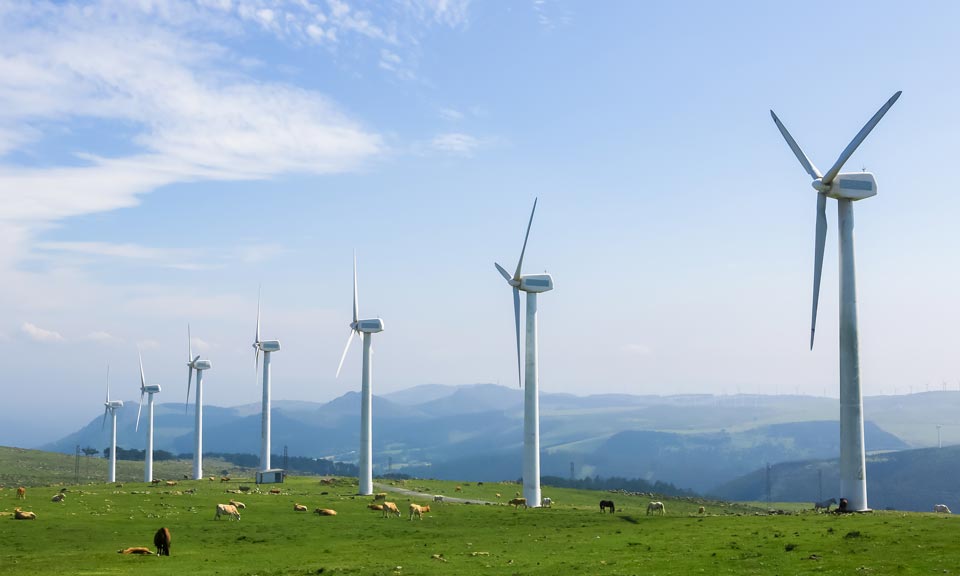Feature: Hungry for green energy, chemicals giant BASF steps into renewables ring

With roots in Germany's industrial heartland dating back to 1865, chemicals giant BASF is readying itself for carbon neutrality. As it builds a foothold in the renewable energy space, the company is morphing from buyer to producer of green electricity.
Boasting a market capitalization of nearly Eur47 billion, BASF makes products including fertilizers, industrial gases, electronic-grade chemicals and glues, which it manufactures at production hubs in Texas, Belgium, Malaysia, China and other global locations.
The company has committed to buy electricity from multiple European wind and solar farms, has taken an equity stake in a Dutch offshore wind farm, is bidding for another one and in January established a dedicated renewables division.
In setting up BASF Renewable Energy, the company is making renewables part of its core business. "This is the extension of our existing approach of integrating ourselves in the value chain for key inputs," Horatio Evers, CEO of the new division, told S&P Global Market Intelligence.
BASF, which already generates most of its own electricity through steam and gas turbines, has a goal is to "provide a secure, ideal portfolio of renewables," Evers said. Its "make and buy" strategy includes building up its own capacity while buying electricity through long-term power purchase agreements.
Such activities have accelerated in recent months. In November 2021, the company signed a 25-year PPA for green electricity with French utility Engie, encompassing up to 20.7 TWh of power. This came after buying a 49.5% stake in the Hollandse Kust Zuid offshore wind farm in the Netherlands from Vattenfall, of which BASF agreed to sell half to German insurer Allianz at the end of the year.
More recently, BASF bought a stake in a company called Vattenfall Hollandse Kust West VI, with Vattenfall and BASF confirming April 22 that they will bid for the 700 MW Site VI concession in the Netherlands' Hollandse Kust West offshore wind tender. The tender opened April 14 and closes May 12, with the winners set to be announced after the summer.
Having a more involved BASF in the construction and planning of offshore wind farms would be a welcome development, according to Martin Neubert, chief commercial officer at Danish wind developer Ørsted.
"There is a huge amount of [interest] from industry to directly secure, procure and be part of development," Neubert said at industry group WindEurope's annual conference in Bilbao, Spain, on April 6. "I think it's good, in terms of how we best allocate resources, capabilities, but also risk. An open-door approach empowers the industry to ramp up."
Ørsted will sell 186 MW of output from its 900 MW Borkum Riffgrund 3 wind farm in Germany's North Sea coast to BASF under a 25-year PPA. The project is expected online in 2025.
Buying green power under long-term PPAs allows BASF to secure the required volumes at predictable prices, Evers said.
The deals also help reduce BASF's direct Scope 1 and 2 greenhouse gas emissions -- those associated with its own production and purchased energy -- which stood at 21.8 million mt of CO2 equivalent in 2020, according to S&P Global Trucost, having barely changed since 2016. German utility RWE more than halved its direct emissions during that time.
BASF wants to reduce its Scope 1 and Scope 2 emissions by 25% by 2030, compared with 2018 levels. For those scopes, the company is targeting net-zero by 2050. Home country Germany, by comparison, has a net-zero target of 2045. To support its goals, BASF wants to spend around Eur4 billion on low-carbon technologies by 2030.
The company does not have a target for Scope 3 emissions, which arise from customers using its products, but said it aims to be "among the first companies to provide large volumes of as many products as possible with reduced carbon footprints."
Renewable electricity will help to decarbonize the company's activities, but many processes rely on natural gas or gas-derived hydrogen and cannot be directly electrified. Fertilizer ingredient ammonia, for instance, is made using gray hydrogen, produced with natural gas, including by BASF.
The company uses around 1 million mt of hydrogen per year across its global operations, and flagship location Ludwigshafen in western Germany makes around a quarter of this hydrogen.
To clean up these polluting operations, EU policymakers want chemicals companies to switch to green hydrogen, which is made with renewables and electrolysis. BASF's renewables unit welcomes this plan, Evers said, while calling for a targeted approach and focus on specific use cases.
"Hydrogen alone will not solve all of our problems," the executive said. "For the production we will also need vast amounts of renewables that we currently do not have."
As a result, deployment of hydrogen needs to happen in areas that are directly reliant on hydrogen, such as chemicals and steel, Evers said. Policymakers ought to prioritize these sectors over power generation or heating, where sufficient alternatives exist. "Precious hydrogen should not be wasted," Evers said.
As the market and production capacity for green hydrogen ramps up, BASF also wants production to take place near existing hubs like Ludwigshafen, while a gas network for long-distance transport is built up for the medium to long term. To that end, the company will build an electrolyzer in Ludwigshafen starting this year, subject to subsidy approvals.
"We know how power-intensive electrolysis is," Evers said. BASF is testing a supplementary method of hydrogen production at the site, called methane pyrolysis, which the company says uses less electricity. The process splits gas into hydrogen and solid carbon and produces no greenhouse gas emissions if run on renewables, according to BASF.
The approach is not without critics.
"Methane pyrolysis is almost as bad as the current major process of producing hydrogen," Mark Jacobson, professor of civil and environmental engineering at Stanford University, said in an email. This is chiefly because of gas leakage in the value chain, while the green energy required to power pyrolysis is prevented from replacing coal and gas in power generation, Jacobson said.
Europe's industries will also tap hydrogen in a pivot from Russian gas usage, with the EU committed to stopping all imports by 2027 in light of Russia's invasion of Ukraine. This shift will be felt strongly in German industry, as the country is heavily reliant on Russian gas, importing more than half of its supplies from there via pipelines. BASF's stock declined sharply as Russia invaded Ukraine and is down 18% in the year to date as of April 13.
The company also owns a majority stake in Wintershall Dea, one of the financiers of the now-shelved Nord Stream 2 gas pipeline; Wintershall took a Eur1 billion impairment on that project.
News
Geopolitical pressures — including rising resource nationalism and a year in which over 50% of countries will be having elections — as well as inflationary pressures have sent energy transition progress into “discord.” A specialty chemicals panel session held March 19 at the World Petrochemical Conference by S&P Global in Houston, Texas, tracked the challenges and opportunities of the energy transition for the industry. Speaking at the session, Roman Kramarchuk, head of climate markets and policy analytics at S&P Global Commodity Insights, said that if the short-term scenario continues, global temperatures could rise 2.4 degrees Celsius by 2100, far above the Paris Agreement’s goal of a 1.4-degree increase. “Over the past few years, we’ve certainly been trending more towards our ‘discord’ scenario,” Kramarchuk said. “We’re trending toward a longer runway for fossil fuels and less [greenhouse gas (GHG)] emission reductions. This is a case of less GDP growth, less trade and less technology transfer.” Since 1990, world GHG emissions have grown 45%, with mainland China, India and the Middle East representing the biggest increases in emissions, at 304%, 241% and 181%, respectively. Over the last 25 years, the Commonwealth of Independent States and the EU have cut their emissions the most, with decreases of 39% and 31%, respectively. The US has cut emissions 1% since 1990. Of S&P Global Commodity Insights’ three energy and climate scenarios, only one, “green rules,” has global temperatures near the Paris Agreement’s 1.5-degree goa, with an expected increase of 1.7-degrees Celsius by 2100l. The “green rules” scenario, however, assumes more technology transfer, cooperation and policy-driven outcomes than is currently happening. “2030 is not that far away,” Kramarchuk said, “and when you think about what the energy transition will take, solar panels can be constructed fast, but anything beyond that — like an onshore or offshore wind plant or a nuclear unit — we’re getting into lead times of 5, 10, or 20 years.” While the US Inflation Reduction Act has helped speed these transformational energy products along, there are still a lot of slowdowns in permitting, especially in Europe. “We joke that there needs to be a ‘Complexity Reduction Act’ in Europe to move things forward,” Kramarchuk said. Harald Schwager, deputy chairman of Evonik Industries AG’s executive board, added that companies are stuck in a hard place. Evonik has signed power purchase agreements (PPAs) to be powered fully by renewable energy by 2030. “The question will be, will production capacity be hampered by the regulatory process and will we have sufficient infrastructure in place to transport enough renewable power for site demand by then,” Schwager said. Distant peaks Commodity Insights’ energy and climate base case pegs the peak years for coal, oil and gas demand to be 2022, around 2030 and 2040, respectively. “When there is a surprise need for energy,” Kramarchuk said, pointing toward the COVID-19 pandemic and a drought in China, which caused a boost in coal usage, “fossil fuels fill that need.” However, “there’s more investment in renewable capacity than we’re seeing in upstream oil and gas,” Kramarchuk said. Under all scenarios, renewable electricity will be the lion’s share of newly generated energy sourcing. Rebecca Liebert, president and CEO of Lubrizol Corp., said that it is the duty of specialty chemical producers to be agile and proactive in bringing innovative and more sustainable products to market. “Political and technical factors are all things we must account for in our bring-to-market timelines. And we get it right a lot of times, but we get it wrong some of the time. Sometimes you get to market before the market is ready for your product. And I think that’s great, to have a solution on the shelf as the market comes along.” Schwager agreed: “In the specialty chemical industry, we have more good ideas than we have money. And there’s no regret on moves for improved efficiency.” While there has been little movement on target setting and market-based mechanisms for growing renewable energy, COP28’s first global stocktake committee called for “countries to contribute to triple global renewable energy capacity and double global energy efficiency by 2030.” “Even though we are heading for the discord path right now, with all the technology solutions and innovation pushes, we’ll be shooting up ahead towards the ‘green rules’ scenario in the long-term,” Kramarchuk concluded. This article was first published in chemweek.com .

News
Two NGOs appealing against permits Initial plan was to start end of 2023 BASF is facing a delay of the operational start of its newly built precursor cathode active materials (pCAM) plant in Finland due to two non-governmental organizations (NGOs) appealing against already-granted permits, a spokesperson for the German petrochemicals company confirmed to S&P Global Commodity Insights Feb. 27. BASF initially aimed to start commercial production at the Harjavalta plant at the end of last year. “The necessary permit to operate this plant has been granted last year by the relevant authorities,” the spokesperson said. “However, two NGOs have filed an appeal against the already granted permit. Next steps and timing will depend on the furtherance of the judicial process before the Vaasa Administrative Court,” said the spokesperson. The pCAM plant will use renewable energy resources, including hydro, wind and biomass-based power and will be supplied with nickel and cobalt from Nornickel’s adjacent refinery. The plant is part of BASF’s plan to supply the battery industry and subsequently automotive industry with lower carbon emission cathode active material. Platts, part of S&P Global Commodity Insights, assessed cobalt metal in-warehouse Rotterdam at $15/lb on Feb. 26, stable from the previous assessment Feb. 23, while the nickel-cobalt black mass EXW Europe payables was at 54% Feb. 26, also stable.

News
The petrochemical landscape has been transformed in recent years by new technologies and the global energy transition, resulting in numerous production pathways and the development of more sustainable products. S&P Global Commodity Insights has created Chemical Connections , an interactive chart which shows the links between chemicals, from upstream feedstocks to derivative products. The second slide offers a map showing our price assessments and benchmarks for chemicals across the value chain around the world. These prices are used by market participants daily to write contracts, monitor their markets and achieve full transparency around transactions.